The beginning of the first academic year after the adoption of the Status Law is clouded by a state of uncertainty on several levels.
- The Ministry of the Interior left the adoption of the official school year to the last minute, as winter is longer, summer vacation is shorter, and the academic year is longer. The government also postpones announcing the executive provisions of the Personal Status Law.
- The legal relationship of teachers will change from January 1, and information about the new legal relationship must be provided in September. Teachers who refuse to change must announce it in the second half of September, but their legal relationship with the public employee will only end at the end of November.
- It is not known how many teachers will leave during this period due to the law, which worsens their position as employees and reduces their independence. The government’s departure does not matter, but rather the unions do, and there are thousands of resignation letters recorded in the file. There have also been reports that some school districts They try to make it difficult Departure of teachers. Many have left the field in tears recently.
- By mid-July, the number of teacher advertisements on the government’s job advertisement website had jumped to 3,200, an increase of 700 in the two weeks following the vote on the status law. By the beginning of the school year, this number had fallen to less than a thousand children.
- Although the status law allows selective wage increases depending on the employer’s decision and financial situation, this does not change much the very low wages of Hungarian teachers at the European level, and the more significant overall improvement in wages – i.e. making them make up 80 percent of wages. Average graduate wages compare to current teacher salaries of 59%, which are expected to increase by 21% this year, 25% next year, and 29% in 2025 – and the promise remains.
- Inflation in Hungary, which is a record high in Europe, and the ten-month decline in real wages in Hungary are also factors affecting teacher salaries, which were already low and undeservedly low – inflation has long since eliminated the increase. Last in wages. Meanwhile, the cost of starting the school year is between 20,000 and 50,000 Hungarian forints this year. Costs To the guardian, A According to the Central Bureau of Statistics On average, the prices of school supplies have risen by about 20 percent and school meals by 33 percent since last July.
- Due to the budget situation, many investments have been made in kindergartens and school development in the deprived Pest district, 27 to be precise. Frozen by the government.
In addition to these current uncertainties, the Hungarian education system is also strained by overarching structural problems: teacher shortages, deteriorating student performance, inequalities inherent in the system, and amplification of socio-economic differences.
Widespread shortage
Since the number of students has declined at a faster rate than the total number of teachers in recent years, it is clear that all teachers are enough for all students – which is why they deny Governmental entities Teacher shortage With the number of students per teacher. However, the teacher shortage does not mean that each class lacks a quarter of teachers, but rather that the education system is less able to ensure an adequate supply of specialized teachers. For example There is such a schoolwhere novice teachers must teach upper grades from September.
Not only is the proportion of teachers who do not have appropriate professional qualifications rising sharply, but public education institutions are recruiting teachers to replace those who are permanently absent. Vocational schools have the lowest proportion of substitute teachers, but across all types of training there has been a significant decline in this area since 2016.
Despite the fact that more people applied for educational courses this year than in the last two years, the numbers of substitutes and dropouts show that without structural and professional intervention, this will certainly increase in the future.
Between 2003 and 2019, the percentage of teachers over the age of 50 increased year after year, while the percentage of those under 40 years of age decreased continuously.
The unfavorable age composition of teachers is clearly visible if the age group is projected onto the average age group of employees.

Source: Tuduk Zart study.
From OECD data, it can be seen that Hungary has the lowest number of teachers starting their careers among the countries in the region. The percentage of people under the age of 30 is 14.6% in all OECD member states, and 6.7% in Hungary. In contrast, the percentage of primary school teachers under the age of 30 in Austria is 17.6 percent, in Slovenia 9.2 percent, in the Czech Republic 8.7 percent, and in Slovakia 8.3 percent. In addition, the average age of Hungarian teachers is the highest at 47.2 years. In the OECD, the average is 43 years, in Austria and Slovenia it is 44 years, and in Slovakia it is 45 years.
Between 2015 and 2020, vacant positions for kindergarten teachers doubled, rising from about 2% to 4.3%, but they also increased in primary schools and secondary institutions offering vocational training, that is, vocational schools, from 4% to 6%. Job vacancies are also rising sharply across the entire education sector.
The system’s problems are more concentrated in where children should be cared for most
Disadvantaged schools are disproportionately affected by teacher shortages. In those schools with a very high proportion of cumulatively disadvantaged, the proportion of teaching vacancies compared to all teaching positions has risen from 4 per cent to more than 8 per cent in 5 years.
At the same time, and clearly in relation to the above, the difference between further education opportunities for disadvantaged and non-disadvantaged people is increasing.
The following figure shows the cumulative distribution of disadvantaged and deprived students and all students among primary schools of various sizes, in percentage. The majority of disadvantaged students are clustered in smaller schools, while the majority of students study in larger institutions with over 250 children.

Source: T-Tudok Zrt 2019 KIR-STAT, calculations by Eva Holb.
The Hungarian public education system is not very capable of alleviating the constraints that come from home, which limit secondary and higher education opportunities for students from different social backgrounds. The difference in the odds of continuing education has increased in recent years between disadvantaged and non-disadvantaged students.
Between 2010 and 2019, the proportion of disadvantaged students in vocational education without a high school diploma increased significantly, while it decreased in vocational education that grants a high school diploma and in four-year secondary schools. Almost simplistically, it can be said that disadvantaged Hungarian students are increasingly enrolling in vocational training that does not lead to a high school diploma, while the trend is the opposite among non-disadvantaged students.
These processes also affect higher education opportunities for specific groups – in 2021, the proportion of disadvantaged students was only 2.3 percent among those who graduated in the year of admission and those admitted through the general procedure. Ten years ago, this rate was about 7 percent.
Where were you born?
The system is based on the principle “where you are born, you stay there”: the conservative and extremely segregated Hungarian public education has not improved in almost 10 years in finding and developing talented children from poor family backgrounds – and in this regard, European educational systems have failed miserably. .
The difference in PISA scores by family background in Hungary is the largest in Europe, and the proportion of performance variance explained by family background is also the largest in Europe.
Moreover, the difference in grades between the best and lowest performing students is largest in Hungary: there is approximately 3-4 school years difference between the best and worst performing students at the age of 15 years.
Incidentally, this rate is similarly high in Germany, but there is at least a somewhat smaller share of achievements explained by family background. This is approximately 20 percent in Hungary.
In Hungary in 2018, the number of high-achieving students with poor family background (7.7%) was relatively lower only in Bulgaria (6.5%) in Europe.
The story becomes sadder if we take a look at the 2009 percentage in the European comparison. With a Hungarian rate of 6.4% at that time, we were ahead of Bulgaria, Romania, the Czech Republic, Slovakia, Austria, Germany, Lithuania, Slovenia, Denmark and the United Kingdom.
Between 2009 and 2018, these countries, with the exception of Bulgaria, achieved a significant increase in the equality of opportunity in their education system: Romania increased the proportion of high-achieving students from poor family backgrounds from 2.5 percent to 8.8 percent, and Austria from 4.8 percent to 10 percent . percent, Slovakia from 5.3 percent to 9.1 percent, and Germany from 5.7 percent to 10.4 percent.
Crossing to Romania
This year’s proficiency measurement also showed that distance learning during the pandemic left a rough impression on students’ performance, especially in terms of text comprehension skills, and sharp regional differences were also linked to the deteriorating trend.
- Students in the districts of Cigande, Ideleni, Putnoki, Konhejici, Kemeksi, Niraduni, Hevesi, Hajdhadhazi, Tisavasvár and İbrane did not even reach the average of 1,400 points. Most of the areas with the worst scores are in the northeastern and southwestern parts of the country.
- The best results were mostly achieved by Year 8 students near major cities, with an impressive average of 1,613 points measured in the Bannonhalme area.
The results also show that the already strong relationship between the family background index and competence scores is now even stronger. The average change in proficiency score associated with a one-unit increase in the family background index was 117 points among 10th graders, both in mathematics and reading comprehension.
In other words: If we compared two 10th graders whose family background indicators differed by just one unit, the better-off young person’s arithmetic and reading scores would be expected to be 117 points better than their friend from a more humble background.
Such a difference has never been seen in the history of measurement.
Inequality also occurs in the process of entry into the higher education sector and has increased in recent years. One thing is that a percentage of Hungarian graduates are among those who command the army in the European Union. Between 2004 and 2022, the Hungarian share increase will lag significantly behind that of the EU, and this in itself means a significant decline in competitiveness. .
Another reason is that the social and economic inequality inherent in the process of access to higher education, which is not wide enough by international standards, is growing: it is becoming more difficult to enter the lower income deciles, while it is easier for the upper income deciles. The expansion of Hungarian higher education has not increased, but rather reduced, access to higher education from economically backward areas.
Of course, there remains the general problem that Hungarian teachers are undeservedly low paid in all kinds of comparisons.
It is no coincidence that Hungarian teachers travel to Romania and other neighboring countries to teach.
I will be a G7 supporter!
Support/one-time subscription
Life Public School Begins Education Teacher Shortage School Year Read more in the category






